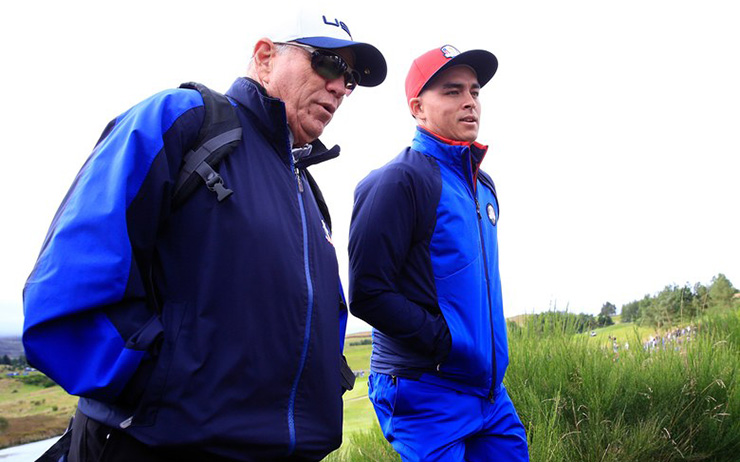Straight talk: Rickie Fowler, with Butch Harmon at the 2014 Ryder Cup, says Butch will “tell you how it is.” (Photo by Jamie Squire/Getty Images)
By Joel Beall
In our biennial poll of the Best Teachers in America, Butch Harmon was the overwhelming top choice according to his instructing brethren. And with good reason. Despite a diverse clientele—from child prodigies to professionals to celebrities to royalty—Butch is able forge a connection with each golfer. “I’m very proud to say that all my tour players have improved on my watch,” Harmon once told Golf Digest. “That’s the only way an instructor can judge himself.”
In honor of Harmon, we’ve compiled a list of the lessons imparted to his star pupils, in hopes they can translate to your game.
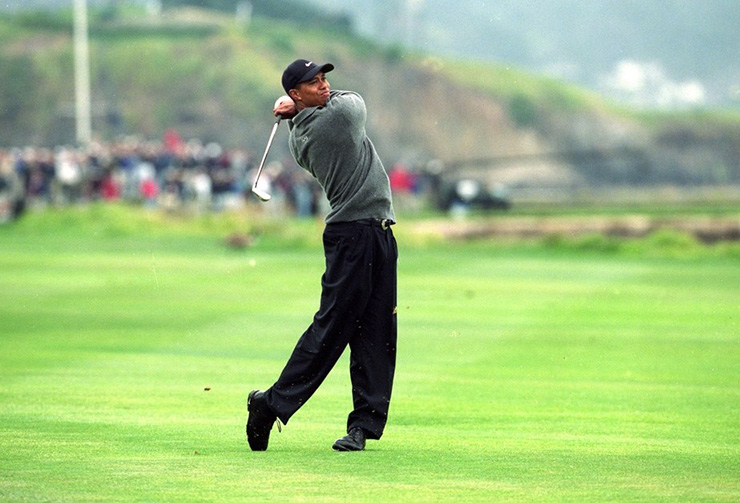
Jamie Squire
Tiger Woods
Harmon started working with Woods in 1993 when Tiger was an amateur and was by his side at his 1997 breakthrough at Augusta National. Regardless of his sensational rise to the pro ranks and his 12-shot Masters victory, Tiger felt his swing was filled with imperfections and shortcomings. According to his self-assessment, Woods believed his club-shaft was across the line at the peak of his backswing, with his club-face closed.
“I agreed with Tiger about the flaws, but I wanted to do it a piece at a time,” Harmon said. “He wanted to do it all at once. I told him it was going to be hard to play through it, and that he might want to do what [Nick] Faldo did with [David] Leadbetter and basically take a year off. He said no, and in 1998 he struggled and won only once.”
But the changes worked. Woods would win eight times in 1999 and followed it with nine Ws—including three majors—in 2000. The main tenet Harmon preached was the importance of keeping the club in front of him more on the backswing and downswing. Due to his outrageous speed, if Tiger was a tad offline, his ball would be all over the ballpark.
“When we worked together, I believed the best way for Tiger to control his distance and direction was for him to keep the club moving square to the target line for as long as possible,” Harmon says. “This required a more vertical swing plane, where the club stayed in front of his chest and his right elbow never got behind his body, and a backswing where the club rarely reached parallel.”
Woods last saw Harmon in 2002, with the pair officially splitting in 2003.
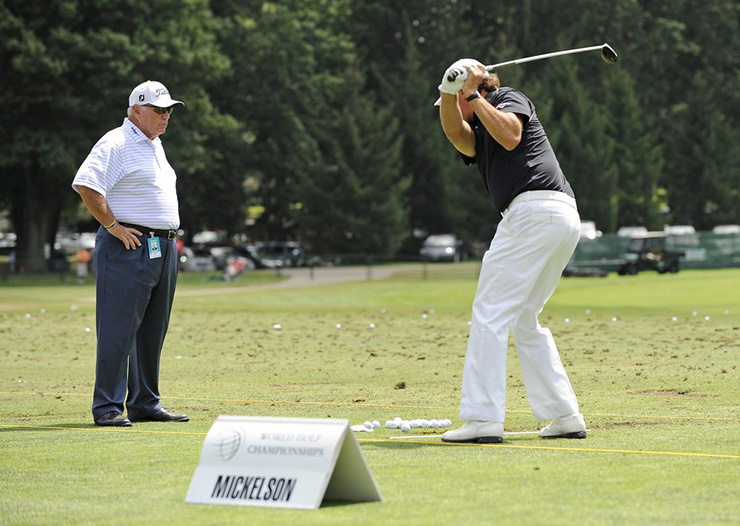
Chris Condon
Phil Mickelson
Mickelson left longtime coach Rick Smith for Harmon in spring 2007, exasperated by his inaccuracy with his driver and irons. The switch paid immediate dividends, as Mickelson won the Players Championship in May. “I felt that if Phil’s technique were better, he’d go from good to phenomenal,” Harmon said.
When Mickelson first met with Harmon, he swung his arms back too far relative to his shoulder turn, creating a long but narrow arc with the club across the line at the top. His hip turn was excessive, his leg action loose. The result: A downswing in which he had to “save” a lot of shots with last-second manipulation of the clubface. He was brilliant at times, inconsistent at others.
During his relationship with Harmon—Mickelson amicably parted ways with him in 2015—the duo worked to make his backswing wider and more effective at setting the club and his body at the top. Why? The ability to execute his go-to shot—a high, slight fade—with ease.
“Phil hasn’t lost any of his creativity at working the ball and adjusting his trajectory,” Harmon says. “The difference is, he doesn’t have to work as hard to do it.”
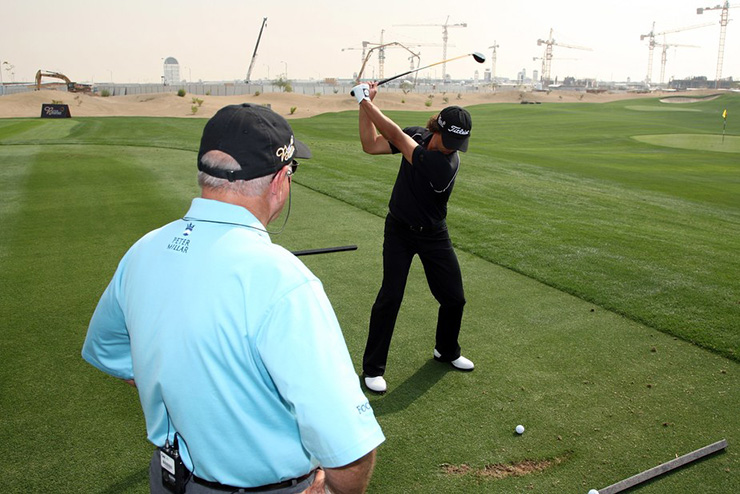
David Cannon
Adam Scott
With a swing seemingly carbon copied from a certain 14-time major winner, it’s easy to accuse Butch of re-creating Tiger’s swing on Scott. Not the case, according to Harmon.
“When Adam came to UNLV from Australia in 1999, he was already swinging this way,” Harmon says. “They have similar builds, and they can do the same kinds of things athletically. I saw Adam and said to myself, ‘Wow, this looks familiar…’ ”
Scott’s swing is so textbook it’s hard to say anything about it, but he said Harmon helped him achieve greater consistency off the tee. “My big problem is that I hang back a little bit at impact. Butch is helping me get fully onto my left side so I can stay on top of the ball. When I do it right, I’m much more accurate with the driver.”
The two separated in 2010.
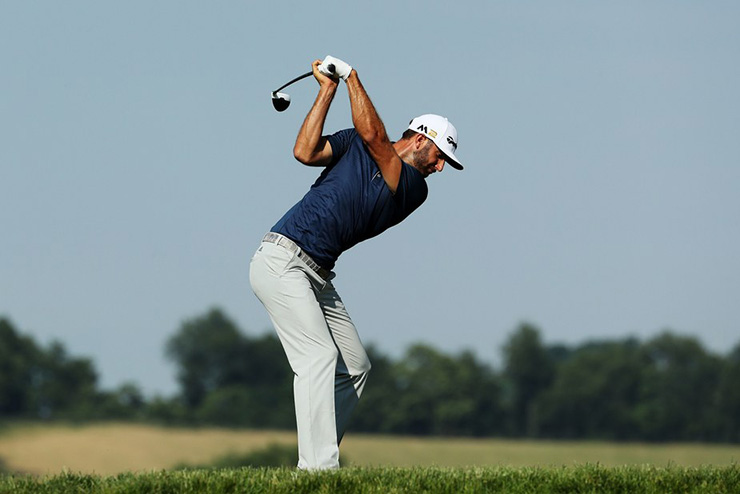
David Cannon
Dustin Johnson
Johnson had experienced some success pre-Harmon—highlighted by a win at Pebble Beach in 2009—but his career took off when he hooked up with the venerable teacher in 2010, with 14 victories in tow since.
Harmon didn’t overhaul Johnson’s distinctive swing—most notably, his bowed left wrist; instead, he tried to erase some of the complexities, like his tendency to over-rotate his hips.
“My thought for him is to stay taller and extend down the target line,” Harmon says. “I tell him to feel like an ostrich, with his neck stretched up at address. It’s a great thought for the amateur player as well: Stay tall, and extend down the line.”
In addition to making tremndous strides in Johnson’s wedge game, Butch was integral in selling the player on the fade off the tee, a shot many believe spurred Johnson to his win at Oakmont and his subsequent heights in the game. “I’ve been trying to explain it for years that he didn’t have to cut across it,” Harmon explains. “He just had to set up left, swing the club back in line of his feet, and instead of curving it, he’d just slide it from left-to-right.”
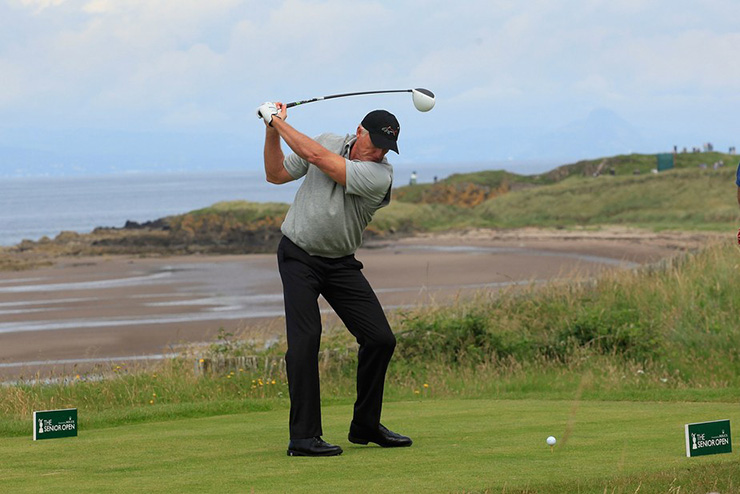
Phil Inglis
Greg Norman
Joining forces in 1992, the former No. 1 Norman was experiencing a slump and sought guidance from Harmon. With a focus on widening his stance, flattening his swing, and modifying his release, the Great White Shark returned to top form, winning the 1993 Open Championship and 1994 Players Championship.
“Greg’s swing thought on the backswing was, ‘Right pocket back,’” Harmon says. “That meant turning his right-front pant pocket behind him. For Greg, it allowed him to maximize his range of motion going back, but it has the added benefit of preventing a sway to the right–a common amateur fault. The sway not only reduces power, it makes it tough to get back in position to hit the ball.”
Harmon’s teaching also helped Norman enter the final day of the 1996 Masters with a six-shot lead. Following his Sunday collapse, Norman blamed the awkwardness of his swing as the cause of the downfall, an excuse some say played a role in the the eventual break-up between the two.
The experience is one Harmon still cites when warning about the challenges of a swing change.
“Regardless of how Greg’s swing changes felt, you don’t get a six-shot lead at the Masters with lousy technique,” he says. “It goes to show that you have to play through the uncomfortable parts and expect it to feel awkward. In fact, when the lesson with your instructor is over and you find yourself getting the hang of a swing change a day later, you’d better schedule another lesson, because I’ll bet you’re not doing it right. It’s very easy for your old swing to sneak up and take hold again.”
Rickie Fowler
Fowler went three years without a coach after his instructor died in 2011, but picked Butch up at the start of the 2014 season. Though Fowler rose to prominence thanks to his athleticism and length, the Oklahoma State product was still too erratic.
“Rickie used to drag the handle back and turn his hips and shoulders very early in the swing,” says Harmon. “The clubhead would lag behind the rotation of his body. Also, his ball position would tend to creep too far back, which contributed to that early turn—he was trying to load up behind the ball.”
The duo worked on timing, syncing up his takeaway by getting the club to keep pace with his body turn, without the clubhead getting left behind. That really simplified his swing and eliminated the need to re-route the club coming down, which caused inconsistency.
“You might have noticed the move he makes over the ball: He practices the first few feet of the swing, making sure he sees the shaft go back right on his toe line,” Harmon says. “That’s on plane.”
While Fowler didn’t win in 2014, he finished fifth or better in every major, highlighted by runner-ups at the U.S. and British Opens. Fowler would go on to win three times in 2015.

Focus On Sport
Seve Ballesteros
Harmon teamed with the late Ballesteros for just a short time in the mid ‘90s. Feeling the five-time major winner had become too robotic, Harmon wanted to get Ballesteros back to his more natural rhythmic swing, one that tried to quiet the noise and focus on fundamentals.
Alas, Harmon considered the Spaniard one of his missed opportunities. “I worked with him a few years ago and thought we had a good run going,” Harmon told Golf Digest’s Guy Yocom in the early 2000s. “But he has spent the last several years looking for quick fixes.”
Despite not having more time together, Harmon’s observations on Balesteros’ short game and vision led to teachings passed on to Tiger Woods, Dustin Johnson, and Rickie Fowler. In fact, Harmon had been instrumental in setting up practice grounds between Woods and Jose Maria Olazabal, another Harmon student, so that Woods could see the Spaniard’s creativity around the greens up close.
“The thing that was phenomenal about Ballesteros was his imagination and creativity,” Harmon told Larry Dorman after Ballesteros’ passing. “He saw things that other players don’t see. He saw shots they don’t see. He was just a genius.”
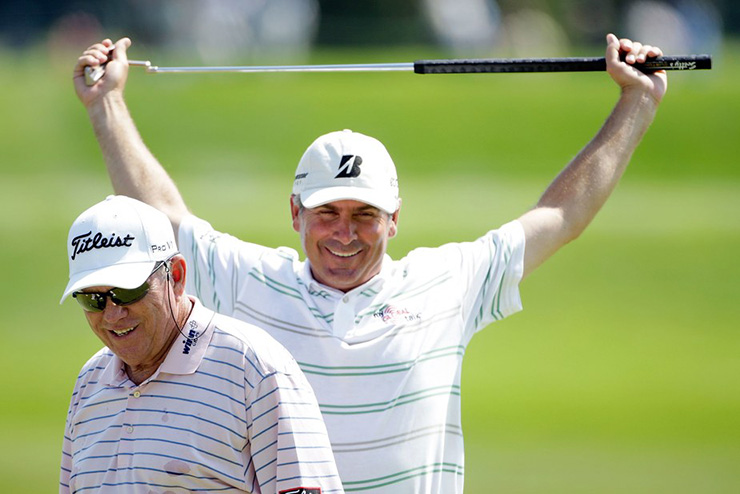
Jamie Squire
Fred Couples
Players usually don’t make swing changes as they near 50. Yet Harmon has worked with Couples on altering his takeaway, lessening his lift with a lower and wider sweep to start the club along the target line.
“We had him setting up with the clubhead a foot behind the ball, getting a head start on the takeaway,” Harmon says. “He even played some rounds like that.”
The change allowed him to accomplish a deeper, fuller turn, which correlated to finding more fairways. The pursuit worked. Couples has won 13 times on the Champions Tour since the fix.
“For a feel player like Fred, any technical change is going to seem pretty drastic, and it’s going to be hard to trust,” Harmon says. “Obviously, it’s easy to work on your swing on the practice tee, but having the courage to try to post a number with it is another matter. A lot of amateurs get into the habit of using their old swing on the course and their new swing on the range, hoping that the change will work its way into their game. Unfortunately, it doesn’t happen that way. Take your swing change onto the course as much as you can, and the sooner the better. It might be torture for a while, but that’s how you learn to trust it under pressure.”
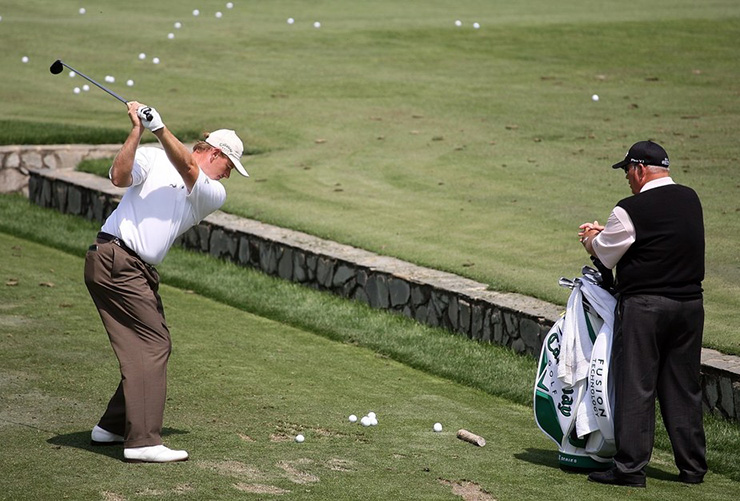
Andy Lyons
Ernie Els
The man nicknamed “the Big Easy” for his smooth, effortless motions felt his swing was out of whack. In a bit of a career lull, the South African switched from friend David Leadbetter to Harmon in 2008. Els was hoping to shorten and tighten his swing, as well as looking for a new perspective.
“Ernie used to slow down his upper body and do everything with his hands at impact,” Harmon says. “Once he learned to stay wide going back, his one thought became turning his chest through to the finish.”
The changes ultimately paid off: at age 42, Els won the 2012 Open, his fourth major championship.
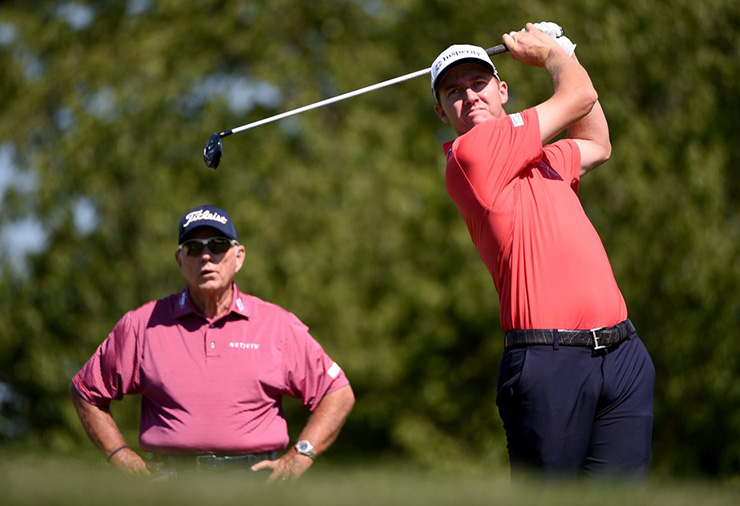
Ross Kinnaird
Jimmy Walker
Walker has been working with Harmon since 2011. Harmon’s approach towards Walker helps illustrate why the teacher is beloved by his pupils: rather than having a universal syllabus or directive, Harmon takes a look at what he has to work with and builds from there.
“We didn’t want to create a new swing,” Harmon says. “Just take what he does naturally and make it better.”
While Waker exhibited great flexibility in his early swing, it worked against him at times. “He has the ability to turn almost too much,” Harmon says. “We’ve reduced his turn a bit so he has an easier time delivering the club to the ball.” Clearly the tweak worked: a late bloomer, Walker has won six times since the start of the 2014 season, including the 2016 PGA Championship.

